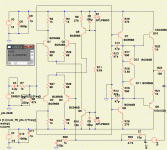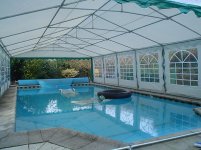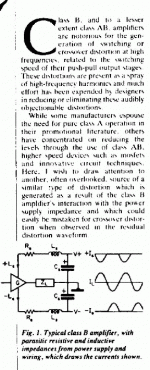No, the vast majority of ClassA amps do not draw constant current from the supply rail. The few that do draw constant current are rarely implemented.lumanauw said:....ClassA will have constant draw of supply rail, like putting a very large constant shunt regulator to power supply.
PMA said:Edmond -
who 'we don't need it' ?
Have you ever done comparative listening tests of low idle amps against class A, both 'properly designed' ?
If yes, tell us the difference. If not, do not speculate about inaudibility.
You do need to make all power range class A. You may stay at such low idle current like 1A to cover first 10 - 20W in a class A. Still, the difference is high compared to cold amplifiers.
Pavel,
1. I asked you to enlighten us with an example of a sub ppm class-A power amp. Do you know of such amp?
2. Sure, class-A sounds slightly better than main stream class-B amps. However, the latter were apparently less than 'properly designed'. But this is all beside the point, as I was talking about sub ppm amps, i.e. ultra sophisticated ones. Regrettably, I had never the change to do a comparative listening test of class-A and sub ppm class-B amps. Maybe Ovidiu (syn08) can tell us more about the PGP vs class-B listening experience. If my own TCP (terrible complex power) amp is finished (next year?) I can tell you more.
BTW, did you ever listen to a Halcro or an amp with comparable performance?
PS: That TCP thingie of mine does operate in class-A up to say 30W, that is, both P and N channel devices contribute with a substantial amount to the output current. Sill I would call it (optimally biased) class-B.
G.Kleinschmidt said:Well that is a pretty lame responseI was thinking perhaps something along the lines of a discussion on the bandwidth limitation (of the global loop) imposed by an OPS using its own compensated negative feedback loop.
That would be something to resurrect the Negative Feedback thread for.
Cheers,
Glen
Glen,
Indeed, that was a pretty lame response, sorry. But did I have a choice? Not really, as the only way to make a serious contribution to your project, means that I have to redraw and simulate your design. Regrettably, I don't have all the time of the world, so I can't do that.
Cheers,
Edmond.
PS: In your latest version, the tube has gone. Why?
As a new learner , even through I read (somewhere) class A
is for novices, I decided to "play" with a JC2 type class A preamp.
So sick of swapping patchcords, For 10$ .. why not.
The lack of switching seems to make any distortion just H2...
biasing is easier ( just like a permanent overbias)
No thermal compensation ( just a big heatsink).
Distortion can be made pretty low as well.. So this is why
everybody downloads all my class A schemas (2:1 ratio over
D and B/AB..
OS
is for novices, I decided to "play" with a JC2 type class A preamp.
So sick of swapping patchcords, For 10$ .. why not.
The lack of switching seems to make any distortion just H2...
biasing is easier ( just like a permanent overbias)
No thermal compensation ( just a big heatsink).
Distortion can be made pretty low as well.. So this is why
everybody downloads all my class A schemas (2:1 ratio over
D and B/AB..
OS
Attachments
jacco vermeulen said:Maybe you gentlemen should meet at the halfway mark ?
Question is whether a subby 1ppm optimal high biased Class AB amp with EC makes a difference, compared to a radiator amp that dips into heavily distorted B territory when it crosses the Class A border.
AHold
Hi Jacco,
It makes a big difference, but, admittedly it's a bit comparing apples with oranges. The JC1 amp for example, uses high biased BJTs and indeed, when it enters the class-B territory distortion rises considerably.
On the other hand, the 'subby' ppm power amp that I envision, uses moderately biased MOSFET. As you know these kind of devices have a much larger and much smoother overlap region. Also, opposed to BJTs, they don't exhibit the "whole storage effect". But that's not all. I also have an automatic bias circuit in mind that also prevents that the MOSFETs are completely turned off. As a result, there ain't no critical border above which the distortion increases rapidly.
Regards,
Edmond.
BTW, WTF has Ahold to do with this subject? Same kind of fraud I guess. Your jokes always surprise me.
ClassA will have constant draw of supply rail
I'm really wondering why this legend still survives
I'm not aware of any popular ClassA amp that has constant current draw.*
Every push-pull ClassA amp, even single-ended designs as the Alephs do not follow this 'rule'.
Have fun, Hannes
*sorry I do not have any clue about tube gear, so maybe I'm missing a lot of these.
EDIT: maybe one of Nelsons early Zens draws constant current.
Edmond Stuart said:ignorant AH
I despise vd Hoeven, just as i despised J.Timmer and C.Beanstra,especially as the latter one has a bigger boat than moi : Palmyre
Can't help the cynical stuff, it's heriditary.

Originally posted by PMA What ?
Pavel,
whether Class A or not, Hawksford/Cordell/Takahashi/Gunderson/Ovidiu/Stuart-Verijn et alii Error-Corrections are technically smarter ways than classic Miller compensation schemes.
I don't have a religion, i'm just a pute who listens to every messiah.
Lately i find Mr GK's wanderings very entertaining, looking forward to witness the VCP, and for the kids i still need a couple of your DisPre2 boards.
For the final "customer" it makes little difference whether it's complex low ppm or a l'ancienne hot, he just looks at the price tag.
Some have to compromise or think environmental thoughts more/less than others.
Attachments
PMA said:What would you say, Jacco?
To me, the sound of class A does not justify the cost of building and operating the amp.
You can't get a whatever class AB amp, bias it into class A and expect better results. Class A needs special design care (not that it's rocket science
syn08 said:does not justify
Suppose you came up with a PFP (Pretty Fat Power amp) in the JC-1 power level league, how much lower would the electricity bill be ?
PMA said:BTW, I have tried several topologies, including error correction, and finished with class A, better say high idle current AB, no global feedback power amplifier.
Whatever makes you happy. Simple and expensive to build, it seems to be a last chance recipe to succeed in the high end audio market.
jacco vermeulen said:
Suppose you came up with a PFP (Pretty Fat Power amp) in the JC-1 power level league, how much lower would the electricity bill be ?
At full power, I guess the PFP and JC-1 yields are the same (being both class AB). The only difference comes from the idle power. The PGP takes 40W in idle (that is, 0.2W per output watt) while the LC-1 takes (according to the spec) 250W in idle (that is, 0.31W per output watt). Accordingly, the equivalent PFP would take only 160W in idle, that is 90W lower. Pretty much nothing.
But look at the gap in performances
For the record, I have never built a Class A amp with a rated output greater than 25W. Yet, I make amps that are rated up to 800W into 4 ohms. NO, it is not class A, more like Class AB1 and user switchable to run Class AB2.
Now, WHY do I run the quiescent current were I run it?
Before I get a run of other people's responses, let me give mine.
I run in Class A as much as possible, and GENTLY move into Class AB or B as the power increases. The limit of Class A operation is set by the amount of heatsink that the amp has designed into it (I don't design the heatsink).
I do this, because most of the time, while listening, I know that the user will be in the Class A region, and I have found it to have less 7th harmonic than an equivalent Class AB2 setting, at the same output power. I know this because I have a SWITCH on the back of the amp that anyone can use. Want to save power? Flip the switch! Want lowest higher order distortion, flip the switch back to normal mode. I can measure the difference below 110 dB. Is it worth it? I think so, but it is YOUR choice. The THD remains essentially the same, as just a number.
Now, think that over, fellow engineers, and IF that is not good enough for you, Class D is a possible and practical alternative.
Now, WHY do I run the quiescent current were I run it?
Before I get a run of other people's responses, let me give mine.
I run in Class A as much as possible, and GENTLY move into Class AB or B as the power increases. The limit of Class A operation is set by the amount of heatsink that the amp has designed into it (I don't design the heatsink).
I do this, because most of the time, while listening, I know that the user will be in the Class A region, and I have found it to have less 7th harmonic than an equivalent Class AB2 setting, at the same output power. I know this because I have a SWITCH on the back of the amp that anyone can use. Want to save power? Flip the switch! Want lowest higher order distortion, flip the switch back to normal mode. I can measure the difference below 110 dB. Is it worth it? I think so, but it is YOUR choice. The THD remains essentially the same, as just a number.
Now, think that over, fellow engineers, and IF that is not good enough for you, Class D is a possible and practical alternative.
All the arguments against it are based on the heat dissipation, one way or another. If it weren't for the heat, everybody would design class A amps, all the time. The other classes would be no more than laboratory curiosities...gee, who'd a thunk it'd work?...and this would be a pointless discussion.
(Or perhaps these folks intend to design class B preamps from now on?)
So the question then becomes: Is it worth the heat?
Those who think THD is a total descriptor will be predisposed to say no. 'Predisposed,' I said; it's not a one to one correspondence. Those who think there are more things than dreamt of in their philosophy will lean towards yes. There will be exceptions on each side, but the trend will be clear.
To me, it seems like a no-brainer. Class A. Duh. The heat is welcome in the winter. Get double-use out of your stereo.
Grey
(Or perhaps these folks intend to design class B preamps from now on?)
So the question then becomes: Is it worth the heat?
Those who think THD is a total descriptor will be predisposed to say no. 'Predisposed,' I said; it's not a one to one correspondence. Those who think there are more things than dreamt of in their philosophy will lean towards yes. There will be exceptions on each side, but the trend will be clear.
To me, it seems like a no-brainer. Class A. Duh. The heat is welcome in the winter. Get double-use out of your stereo.
Grey
- Status
- Not open for further replies.
- Home
- Amplifiers
- Solid State
- John Curl's Blowtorch preamplifier



